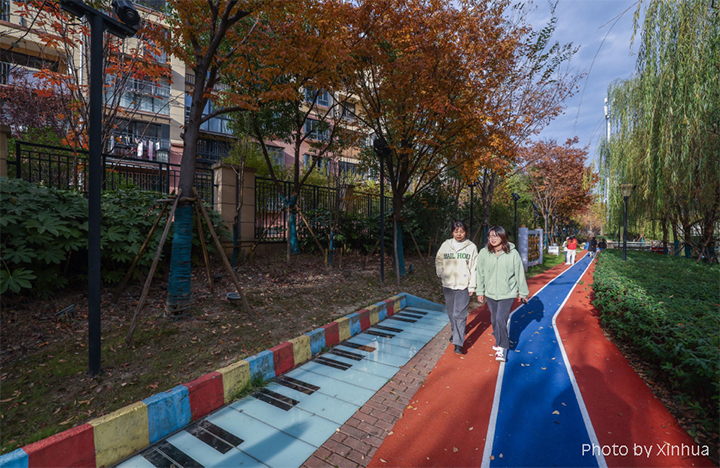



▲ Residents take a leisure walk on the newly built health trail around the river in Xianghe Community, Wuxing District, Huzhou City, Zhejiang Province. [Photo/Xinhua]
Community is the basic unit of urban public services as well as governance. Implementing the urban community-level embedded service facilities construction project with functional facilities and adaptive services involved in the public space of urban communities (residential areas) is beneficial for promoting high-quality and inclusive public services at the grassroots level to better meet the people’s aspiration for a better life. In accordance with the joint decisions and deployments of the Communist Party of China Central Committee and the State Council, the National Development and Reform Commission has formulated an implementation plan to advance the construction of urban community-level embedded service facilities.
1. General Requirements.
1.1 Ensure basic and high-quality public services.
Community-level embedded service facilities aim to provide residents with services including elderly care, childcare, community dining, housekeeping, health services, sports and fitness, cultural and leisure activities, and children's recreation. Following the principles of precision, scale, and market orientation, priority should be given to and focus on providing urgently needed services. Ensure that services are convenient and affordable with guaranteed quality, and other services will be gradually incorporated into such facilities.
1.2 Implement classified measures and promote them in an orderly manner.
Precise strategies should be employed based on the characteristics of different types of cities and communities. Adhere to the principles of construction when feasible, redevelopment when necessary, and plan comprehensively at the city level while implementing at the neighborhood or community level. Coordinate planning, construction, services, and management, and do everything within the capacity to keep enhancing public services.
1.3 Encourage innovation and launch pilot initiatives.
Respect grassroots innovation, clarify responsibility for local governments in organizing implementation, capital investment, and construction management, and the central government strengthens overall promotion and guidance. Encourage cities to take the lead in experimenting and reforming, fully leveraging policy incentives and exemplary demonstration.
1.4 Strengthen relative mechanisms for sustainable development.
Adhere to a better combination of efficient markets and competent government, coordinate and mobilize social resources, improve the institutional mechanisms for expanding high-quality public services to communities, and actively explore diverse construction and operation models such as public-private partnerships and public-private assistance. Effectively leverage and utilize existing urban resources to achieve sustainable development of community-level embedded services.
2. Implementation Objectives.
The construction scope of the urban community-level embedded service facilities covers various types of cities, with a priority on large cities with a permanent urban population of more than 1 million. Taking into account factors such as population distribution, local conditions, and financial capacity, about 50 cities will be selected to deliver pilot projects. Each selected city will choose approximately 100 residential communities as the initial trial projects to provide one-stop community services for the residents
By 2027, such community-level services will be rolled out in other cities on the basis of summarizing the experience and effective models developed from the pilot cities to provide residents with high-quality public services on their doorstep.
3. Regulate Construction Requirements.
3.1 Scientific and rational lay out the community-level service facilities.
Optimize facility planning and layout with a focus on the service needs within walking distance for community residents, improve the community service system, and lay out the embedded service facilities at the doorstep of the community. Implement the requirement that the average area of community comprehensive service facilities per hundred households is not less than 30 square meters, and support qualified cities to reach no less than 80 square meters. The floor area of the community-level embedded service complex (community service center) is included in the statistical scope of community comprehensive service facilities.
3.2 Improve resource integration and intensive construction.
Promote the construction of community-level embedded service facilities that are of moderate in scale, affordable, and efficient in service through a combination of renovation and new construction. Emphasize the promotion and priority construction (or renovation) of functionally integrated community-level embedded service complexes (community service centers) to provide residents with one-stop community services. For communities that currently are not applicable, construct single-function embedded service facilities instead of the service center. Support the comprehensive development of community-level embedded service facilities in the form of an integrated area planning and development model.
3.3 Expand the space for facility construction through multiple channels.
By demolishing and vacating the existing space in old residential areas, integrating community housing, swapping property rights, acquisition and redevelopment, etc. to construct and renovate a batch of urgently needed community-level embedded service facilities. Encourage and guide property owners to fully utilize existing housing spaces, and prioritize the conversion of eligible sites into community-level embedded service facilities. Allow local governments to provide state-owned properties to the community to develop embedded services while maintaining ownership. New communities should strengthen the construction of supporting community-level embedded service facilities.
3.4 Improve the functionality of community-level embedded service facilities.
The responsible planner (community planner) should widely solicit residents' opinions and demands, encourage residents and the whole society to actively participate in project design, accurately embed service facilities according to demand, and scientifically configure service functions. Encourage the comprehensive setting, compound utilization, and off-peak usage of service facilities, and promote the standardized design of community-level embedded service facilities. Pilot cities should scientifically set up service scenarios, prioritize the setting up of necessary space for infant and toddler nursery places and short-term nursing care beds for the elderly, and avoid replacing the public service facilities with administrative offices.
Source:
<https://www.gov.cn/zhengce/content/202311/content_6917190.htm>
<https://english.www.gov.cn/news/202311/27/content_WS6563ce7dc6d0868f4e8e1a8d.html>
<https://language.chinadaily.com.cn/a/202311/29/WS65668dbea31090682a5f07d9.html>
Edited and Translated by Guo Xinxin